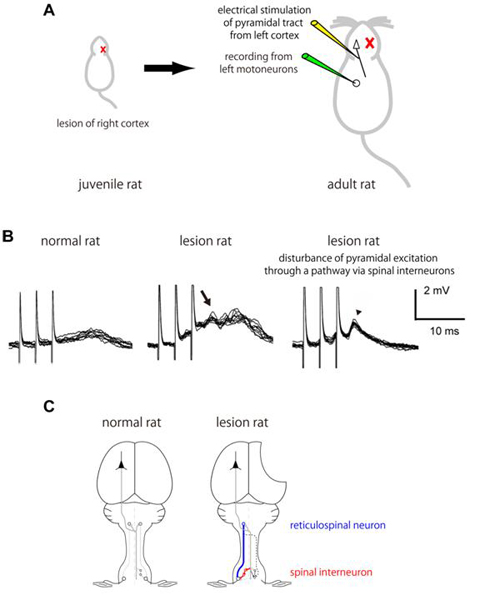Damage to the cerebral cortex caused by stroke in adulthood often leads to impairment of contralateral limb movements. On the other hand, it has been reported that similar brain damage at the juvenile stage results in less impairment. It was shown that adult rodents with neonatal cortical damage exhibited normal motor functions in their limbs on the contralateral side to the damage, while animals with a similar injury at maturity showed poor recovery. As a neuronal mechanism explaining this, corticospinal fibers from the sensorimotor cortex on the opposite side of the lesion issued aberrant collaterals to the grey matter of the spinal cord on the ipsilateral side (Takahashi et al. 2009). However, it is not clear what neuronal circuits mediate motor commands from the undamaged sensorimotor cortex to motoneurons contralateral to the cortical damage.
In this study, we showed that electrical stimulation of the medullary pyramid on the intact side elicited oligosynaptic pyramidal excitation in forelimb motoneurons on the contralateral side to the damaged brain (ipsilateral to the stimulation) in neonatally hemidecorticated rats. We clarified that the excitation was transmitted to the ipsilateral motoneurons by at least two pathways: one via the corticospinal tract and spinal interneurons, and the other via the cortico-reticulo-spinal pathways. Combined with previous histological results (Takahashi et al. 2009), the present results suggested that in neonatally hemidecorticated rats, mediation of motor commands from the undamaged sensorimotor cortex to ipsilateral motoneurons are potentiated due to development of indirect ipsilateral descending pathway.
Tatsuya Umeda, Masahito Takahashi, Kaoru Isa, Tadashi Isa
Formation of descending pathways mediating cortical command to ipsilateral forelimb motoneurons in neonatally hemidecorticated rats.
J. Neurophysiol 104 (2010) 1707-1716
(A) Experimental design. Right cortex of the juvenile rat was lesioned on the 5th postnatal day. After maturation, electrical recording from left motoneurons were performed to detect excitation induced by electrical stimulation of the left pyramid.
(B) Effects of electrical stimulation of the left pyramid on left motoneurons. Oligosynaptic pyramidal excitation was detected in hemidecorticated rats (an arrow), while the pyramidal excitation of motoneurons was much smaller in normal rats. After cutting a pathway via spinal interneurons, pyramidal excitation still remained even though size of the response became small (an arrowhead).
(C) Schematic drawings illustrating functional descending cortical motor pathways. In hemidecorticated rats, pathways from the undamaged sensorimotor cortex to motoneurons on the side opposite to the normal targets developed in addition to the normal descending cortical motor pathways. These connections were mediated via spinal interneurons (red) and reticulospinal neurons (blue).
